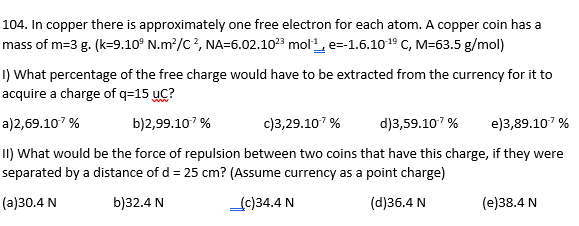104. In copper there is approximately one free electron for each atom. A copper coin has a mass of m=3 g. (k=9.10° N.m²/C2, NA=6.02.1023 mol¹, e--1.6.10:¹9 C, M=63.5 g/mol) I) What percentage of the free charge would have to be extracted from the currency for it to acquire a charge of q=15 uc? a)2,69.107 % b)2,99.107 % c)3,29.107 % d)3,59.107 % e)3,89.107 % II) What would be the force of repulsion between two coins that have this charge, if they were separated by a distance of d = 25 cm? (Assume currency as a point charge) (a)30.4 N b)32.4 N (c)34.4 N (d)36.4 N (e)38.4 N
104. In copper there is approximately one free electron for each atom. A copper coin has a mass of m=3 g. (k=9.10° N.m²/C2, NA=6.02.1023 mol¹, e--1.6.10:¹9 C, M=63.5 g/mol) I) What percentage of the free charge would have to be extracted from the currency for it to acquire a charge of q=15 uc? a)2,69.107 % b)2,99.107 % c)3,29.107 % d)3,59.107 % e)3,89.107 % II) What would be the force of repulsion between two coins that have this charge, if they were separated by a distance of d = 25 cm? (Assume currency as a point charge) (a)30.4 N b)32.4 N (c)34.4 N (d)36.4 N (e)38.4 N
College Physics
10th Edition
ISBN:9781285737027
Author:Raymond A. Serway, Chris Vuille
Publisher:Raymond A. Serway, Chris Vuille
Chapter15: Electric Forces And Electric Fields
Section: Chapter Questions
Problem 39P: Refer 10 Figure 15.20. The charge lowered into the center of the hollow conductor has a magnitude of...
Related questions
Concept explainers
Dielectric Constant Of Water
Water constitutes about 70% of earth. Some important distinguishing properties of water are high molar concentration, small dissociation constant and high dielectric constant.
Electrostatic Potential and Capacitance
An electrostatic force is a force caused by stationary electric charges /fields. The electrostatic force is caused by the transfer of electrons in conducting materials. Coulomb’s law determines the amount of force between two stationary, charged particles. The electric force is the force which acts between two stationary charges. It is also called Coulomb force.
Question

Transcribed Image Text:104. In copper there is approximately one free electron for each atom. A copper coin has a
mass of m=3 g. (k=9.10° N.m²/C², NA=6.02.10²3 mol-¹, e--1.6.10-¹9 C, M-63.5 g/mol)
1) What percentage of the free charge would have to be extracted from the currency for it to
acquire a charge of q=15 UC?
a)2,69.107 %
b)2,99.107 %
c)3,29.10.7 %
d)3,59.10-7%
e)3,89.107 %
II) What would be the force of repulsion between two coins that have this charge, if they were
separated by a distance of d = 25 cm? (Assume currency as a point charge)
(a)30.4 N
b)32.4 N
(c)34.4 N
(d)36.4 N
(e)38.4 N
Expert Solution
This question has been solved!
Explore an expertly crafted, step-by-step solution for a thorough understanding of key concepts.
Step by step
Solved in 4 steps with 20 images

Knowledge Booster
Learn more about
Need a deep-dive on the concept behind this application? Look no further. Learn more about this topic, physics and related others by exploring similar questions and additional content below.Recommended textbooks for you

College Physics
Physics
ISBN:
9781285737027
Author:
Raymond A. Serway, Chris Vuille
Publisher:
Cengage Learning

Principles of Physics: A Calculus-Based Text
Physics
ISBN:
9781133104261
Author:
Raymond A. Serway, John W. Jewett
Publisher:
Cengage Learning

College Physics
Physics
ISBN:
9781938168000
Author:
Paul Peter Urone, Roger Hinrichs
Publisher:
OpenStax College

College Physics
Physics
ISBN:
9781285737027
Author:
Raymond A. Serway, Chris Vuille
Publisher:
Cengage Learning

Principles of Physics: A Calculus-Based Text
Physics
ISBN:
9781133104261
Author:
Raymond A. Serway, John W. Jewett
Publisher:
Cengage Learning

College Physics
Physics
ISBN:
9781938168000
Author:
Paul Peter Urone, Roger Hinrichs
Publisher:
OpenStax College

Physics for Scientists and Engineers with Modern …
Physics
ISBN:
9781337553292
Author:
Raymond A. Serway, John W. Jewett
Publisher:
Cengage Learning

Physics for Scientists and Engineers
Physics
ISBN:
9781337553278
Author:
Raymond A. Serway, John W. Jewett
Publisher:
Cengage Learning

Physics for Scientists and Engineers: Foundations…
Physics
ISBN:
9781133939146
Author:
Katz, Debora M.
Publisher:
Cengage Learning